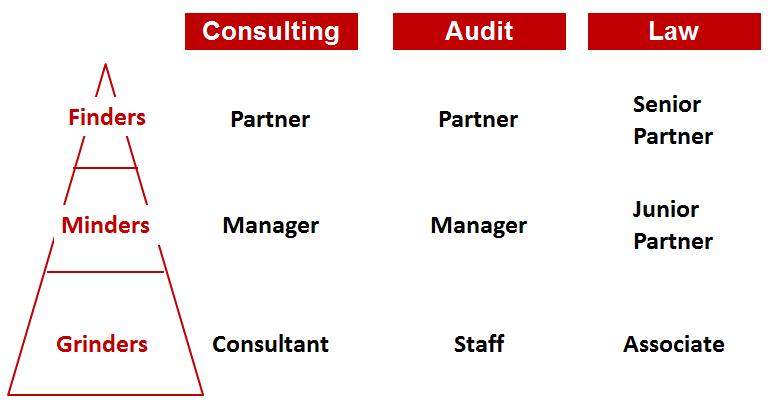Clearly, this is some type of slang, but what does it mean? David Maister coined this term to describe the different roles you find in a professional services organization. Yes, he advised law firms on how to build their practices, but this advice applies to management consulting firms and investment banks too.
The partnership business model
For those interested in the economics of partnerships (who isn’t?), you have to read Managing a Professional Services Firm (affiliate link). It is a collection of articles that Maister wrote over 10 years, but they are timeless truths when it comes to delivering great client work, recruiting and retaining talent, and keeping your “leverage” in check. Maister was a Harvard Business School professor who left (who leaves HBS?), to teach law and consulting firms how to be successful. Basically, he teaches super smart people how to run their businesses.
Finders, Minders, and Grinders
Maister mentions this in the first chapter and this will ring true for anyone who’s worked in Big 3 or Big 4. There are three archetypal roles that roughly line up with these job titles in the respective industries. The shape of the pyramid shows both the number of people at each level; many grinders, fewer minders, and even fewer finders. It also implies the relative hierarchy in terms of respect, experience, compensation.

Finders
These are the ones at the top of the pyramid who find the business. They are usually equity partners. They are owners in the business, and the success of the firm = the personal financial success. They are in-it-to-win-it. They hunt for a living. They spend 80%+ of their time on business development and account management. Their job is not project delivery, their job is to find work that others will deliver on. They are in sales.
Partners and MDs should be taking care of existing clients or finding news ones. They should be training-up the next generation of leaders. They should be managing the practice and making sure the pipeline of talent matches the expected demand. They are the owners of the firm.
Minders
In consulting world, these are the senior managers, engagement managers, and managers. They have relevant experience and spend their days working with clients and keeping their teams busy and on track. They keep the wheels of the projects running. They work for the goal of becoming partner. They seek to please, and frankly, hold the place together. This is a really rewarding role because you influence dozens of junior consultants; you can mentor, coach, help, recruit, train, and invest in younger people.
This is not always rainbows and ponies. Trust me. Late nights, bad team dynamic, broken excel models, grumpy clients. Project UP and DOWNs.
Grinders
These are the bright young stars coming out of top universities 21-25 years old. Smart, impressionable, eager to please, and a bit anxious. They are putting in the long hours figuring out how to do research, run queries on MS Access, and crunch data until it has been pulverized into sand. Junior resources learn an enormous amount on the job. One manager said, “you can actually see them getting smarter”. By the time they have been on a half dozen projects, they are mature beyond their years and fairly self-sufficient. After a few short years in a top consulting firm, their market value likely increases 20-30%.
For any project, you need all three roles and they are not mutually exclusive. Anyone can help “find” repeat business at the client site. Likewise, “minders” often step in an do the heavy lifting work too. That said, these are the archetypes and the typical roles that firms hire into, and you see on projects.
Leverage matters
There is a ratio of between the 3 groups that determines the shape of the pyramid. A tall pyramid implies a lower leverage ratio where there is more time required of the partners and veterans to actually deliver the work. Higher bill rate. The work will likely be more advisory, strategic, and open-ended.
A flatter pyramid implies higher leverage with a larger base of analysts, consultants and associates. Lower bill rate, more process-oriented work which requires significant numbers of people to implement, do the work, etc. . .
Neither is good or bad, it is merely different types of work.
If you really care about how your consulting firm or law firm operates, think about the staffing model and what that means for client service, profitability, and satisfaction. There is a lot more to say on this topic – Maister wrote a 300 page book on it – but it’s 7:15am. Time to leave the hotel and go to the client site to mind and find.

“…. but it’s 7:15am. Time to leave the hotel and go to the client site to mind and find”. Very good!
Absolutely. Thanks for reading.
As a solo practitioner, it can get difficult mining all 3 areas. But I learned early – as a finder – that all (any) business isn’t necessarily good business and a leverage mindset goes a long way.
I really enjoy your writings. Thanks for the insight!
I am so impressed and trigged with the anology of the Finder, Minder and the Grinder. What they do differently to bring and create sustainable change